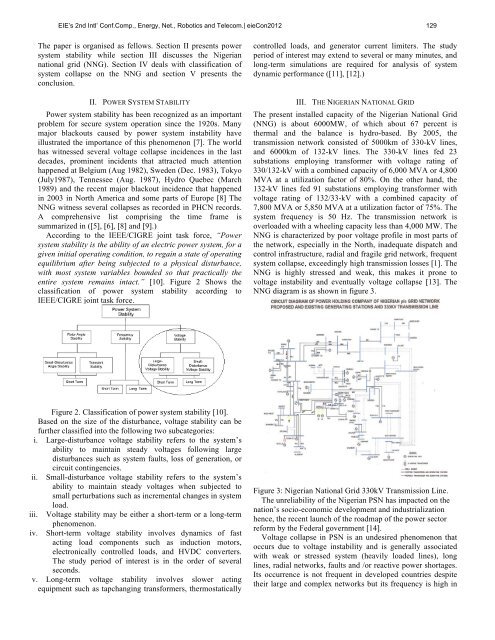Voltage Collapse and the Nigerian National Grid - Covenant ...
Voltage Collapse and the Nigerian National Grid - Covenant ...
Voltage Collapse and the Nigerian National Grid - Covenant ...
Create successful ePaper yourself
Turn your PDF publications into a flip-book with our unique Google optimized e-Paper software.
EIE’s 2nd Intl’ Conf.Comp., Energy, Net., Robotics <strong>and</strong> Telecom.| eieCon2012 129<br />
The paper is organised as fellows. Section II presents power<br />
system stability while section III discusses <strong>the</strong> <strong>Nigerian</strong><br />
national grid (NNG). Section IV deals with classification of<br />
system collapse on <strong>the</strong> NNG <strong>and</strong> section V presents <strong>the</strong><br />
conclusion.<br />
II. POWER SYSTEM STABILITY<br />
Power system stability has been recognized as an important<br />
problem for secure system operation since <strong>the</strong> 1920s. Many<br />
major blackouts caused by power system instability have<br />
illustrated <strong>the</strong> importance of this phenomenon [7]. The world<br />
has witnessed several voltage collapse incidences in <strong>the</strong> last<br />
decades, prominent incidents that attracted much attention<br />
happened at Belgium (Aug 1982), Sweden (Dec. 1983), Tokyo<br />
(July1987), Tennessee (Aug. 1987), Hydro Quebec (March<br />
1989) <strong>and</strong> <strong>the</strong> recent major blackout incidence that happened<br />
in 2003 in North America <strong>and</strong> some parts of Europe [8] The<br />
NNG witness several collapses as recorded in PHCN records.<br />
A comprehensive list comprising <strong>the</strong> time frame is<br />
summarized in ([5], [6], [8] <strong>and</strong> [9].)<br />
According to <strong>the</strong> IEEE/CIGRE joint task force, “Power<br />
system stability is <strong>the</strong> ability of an electric power system, for a<br />
given initial operating condition, to regain a state of operating<br />
equilibrium after being subjected to a physical disturbance,<br />
with most system variables bounded so that practically <strong>the</strong><br />
entire system remains intact.” [10]. Figure 2 Shows <strong>the</strong><br />
classification of power system stability according to<br />
IEEE/CIGRE joint task force.<br />
Figure 2. Classification of power system stability [10].<br />
Based on <strong>the</strong> size of <strong>the</strong> disturbance, voltage stability can be<br />
fur<strong>the</strong>r classified into <strong>the</strong> following two subcategories:<br />
i. Large-disturbance voltage stability refers to <strong>the</strong> system’s<br />
ability to maintain steady voltages following large<br />
disturbances such as system faults, loss of generation, or<br />
circuit contingencies.<br />
ii. Small-disturbance voltage stability refers to <strong>the</strong> system’s<br />
ability to maintain steady voltages when subjected to<br />
small perturbations such as incremental changes in system<br />
load.<br />
iii. <strong>Voltage</strong> stability may be ei<strong>the</strong>r a short-term or a long-term<br />
phenomenon.<br />
iv. Short-term voltage stability involves dynamics of fast<br />
acting load components such as induction motors,<br />
electronically controlled loads, <strong>and</strong> HVDC converters.<br />
The study period of interest is in <strong>the</strong> order of several<br />
seconds.<br />
v. Long-term voltage stability involves slower acting<br />
equipment such as tapchanging transformers, <strong>the</strong>rmostatically<br />
controlled loads, <strong>and</strong> generator current limiters. The study<br />
period of interest may extend to several or many minutes, <strong>and</strong><br />
long-term simulations are required for analysis of system<br />
dynamic performance ([11], [12].)<br />
III. THE NIGERIAN NATIONAL GRID<br />
The present installed capacity of <strong>the</strong> <strong>Nigerian</strong> <strong>National</strong> <strong>Grid</strong><br />
(NNG) is about 6000MW, of which about 67 percent is<br />
<strong>the</strong>rmal <strong>and</strong> <strong>the</strong> balance is hydro-based. By 2005, <strong>the</strong><br />
transmission network consisted of 5000km of 330-kV lines,<br />
<strong>and</strong> 6000km of 132-kV lines. The 330-kV lines fed 23<br />
substations employing transformer with voltage rating of<br />
330/132-kV with a combined capacity of 6,000 MVA or 4,800<br />
MVA at a utilization factor of 80%. On <strong>the</strong> o<strong>the</strong>r h<strong>and</strong>, <strong>the</strong><br />
132-kV lines fed 91 substations employing transformer with<br />
voltage rating of 132/33-kV with a combined capacity of<br />
7,800 MVA or 5,850 MVA at a utilization factor of 75%. The<br />
system frequency is 50 Hz. The transmission network is<br />
overloaded with a wheeling capacity less than 4,000 MW. The<br />
NNG is characterized by poor voltage profile in most parts of<br />
<strong>the</strong> network, especially in <strong>the</strong> North, inadequate dispatch <strong>and</strong><br />
control infrastructure, radial <strong>and</strong> fragile grid network, frequent<br />
system collapse, exceedingly high transmission losses [1]. The<br />
NNG is highly stressed <strong>and</strong> weak, this makes it prone to<br />
voltage instability <strong>and</strong> eventually voltage collapse [13]. The<br />
NNG diagram is as shown in figure 3.<br />
Figure 3: <strong>Nigerian</strong> <strong>National</strong> <strong>Grid</strong> 330kV Transmission Line.<br />
The unreliability of <strong>the</strong> <strong>Nigerian</strong> PSN has impacted on <strong>the</strong><br />
nation’s socio-economic development <strong>and</strong> industrialization<br />
hence, <strong>the</strong> recent launch of <strong>the</strong> roadmap of <strong>the</strong> power sector<br />
reform by <strong>the</strong> Federal government [14].<br />
<strong>Voltage</strong> collapse in PSN is an undesired phenomenon that<br />
occurs due to voltage instability <strong>and</strong> is generally associated<br />
with weak or stressed system (heavily loaded lines), long<br />
lines, radial networks, faults <strong>and</strong> /or reactive power shortages.<br />
Its occurrence is not frequent in developed countries despite<br />
<strong>the</strong>ir large <strong>and</strong> complex networks but its frequency is high in
















